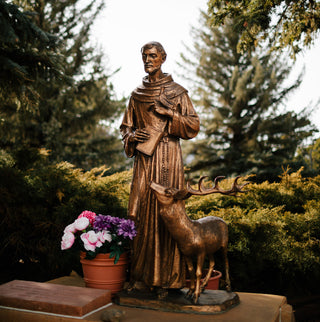Francesco di Pietro di Bernardone was born in 1181 ca in a small town called Assisi, situated in the Umbria region (central Italy). Born to a rich cloth merchant, as a youth Francesco appreciated fine food, crowded company, and enjoyed the French culture of troubadours. His world was filled with violence and Francis himself took part in a war between Assisi and Perugia, at the end of which he was imprisoned. Ransomed by his father, the future saint fell ill and shortly after experienced the first of a series of visions that would ultimately lead him to his true vocation.

The Call of St Damian Crucifix
Before completely embracing poverty, Francis of Assisi had several deeply spiritual experiences that anticipated and prepared him for the kind of life that he would later become renowned for. The one that finally prompted him to change happened at the San Damiano church on the outskirts of Assisi. When praying in front of the altar crucifix, Francis heard a voice that commanded him: “Go, Francis, and repair my house which, as you see, is in ruins.” That very moment marked a before and an after in Francis’ life, who shortly after would renounce his inheritance and family ties before the ecclesiastical court of Assisi in presence of his father. That same year, in 1206, two fellow countrymen joined him, becoming twelve a few years later. That was the beginning of the Franciscan order of the Friars Minor.
Prayer of St Francis
St Francis is known for writing the very first poem in the Italian language, known as “Canticle of Brother Sun” and “Canticle of the Creatures” that celebrates nature as a divine gift. Enjoy it here below:
The Patronage of Saint Francis of Assisi
The Assisian Saint is celebrated on 4 October and together with Saint Catherine of Siena is the patron of Italy. Because of his deep feeling for nature, Pope John Paul II officially proclaimed him the patron saint of ecology in 1980. St Francis is, in fact, usually depicted in the company of animals, most of all wolves.
The story of St Francis of Assisi and the wolf was quite popular back in the Middle Ages. According to it, the saint confronted a wolf that terrorized the residents of the Gubbio town. After reprimanding the carnivore, Francis made a deal with it by bargaining food in exchange for people’s lives.
Related Articles:
Franciscan Rosary: What is it and How to Pray it→
TAU: Meaning and Origin→
5 types of crosses and their meanings →













